Unit 5 Meeting your ancestors
文档属性
| 名称 | Unit 5 Meeting your ancestors | 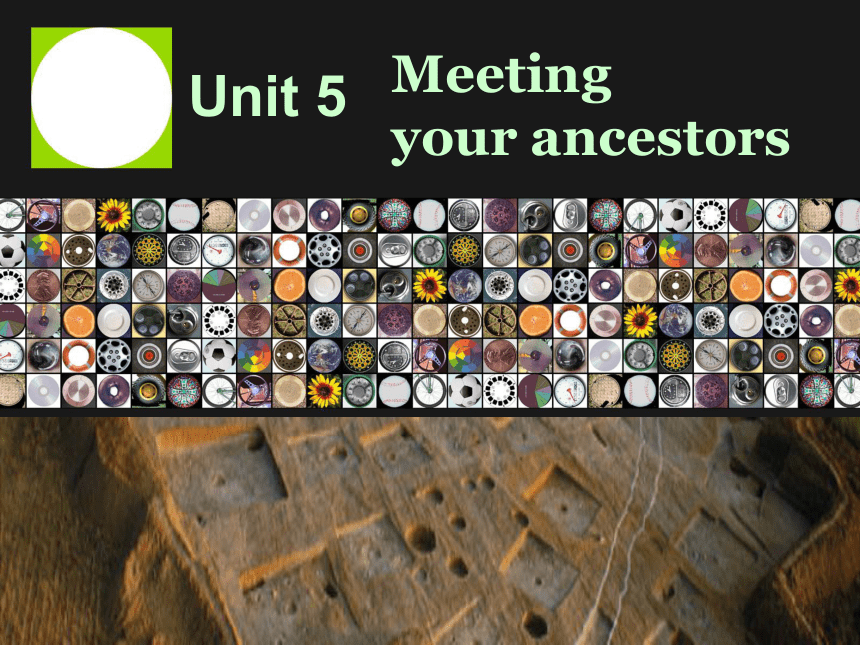 | |
| 格式 | zip | ||
| 文件大小 | 6.9MB | ||
| 资源类型 | 教案 | ||
| 版本资源 | 人教版(新课程标准) | ||
| 科目 | 英语 | ||
| 更新时间 | 2012-07-17 22:11:59 | ||
图片预览

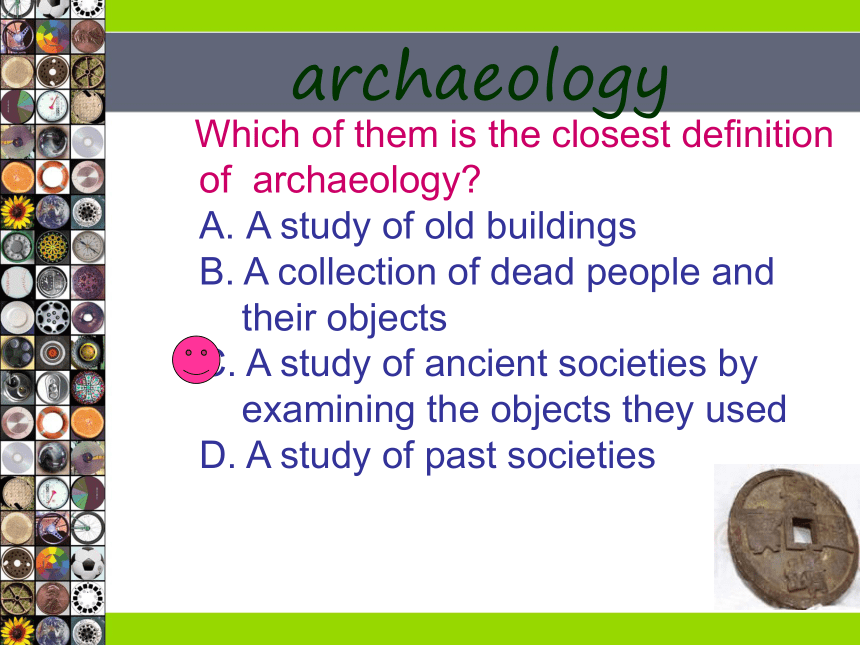
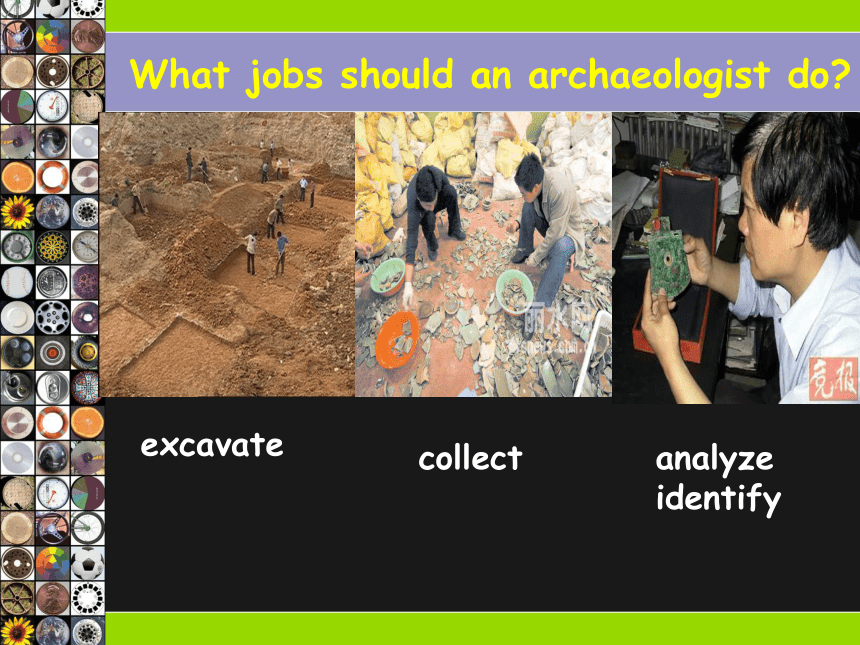
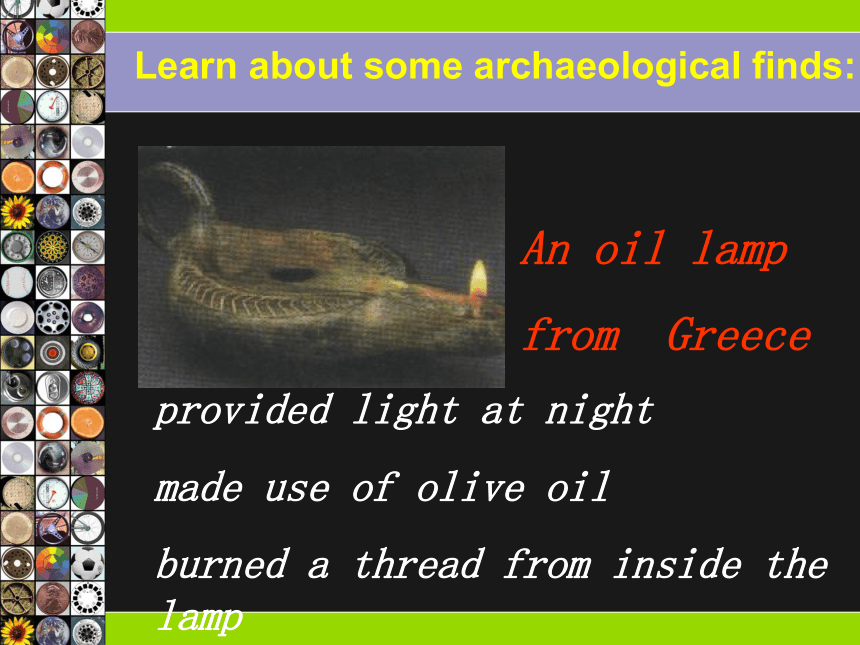
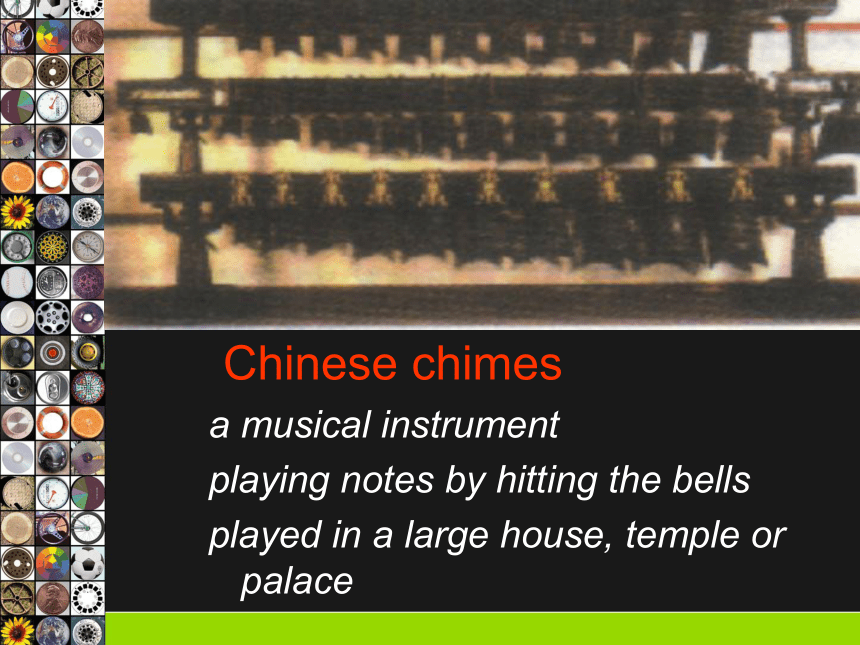
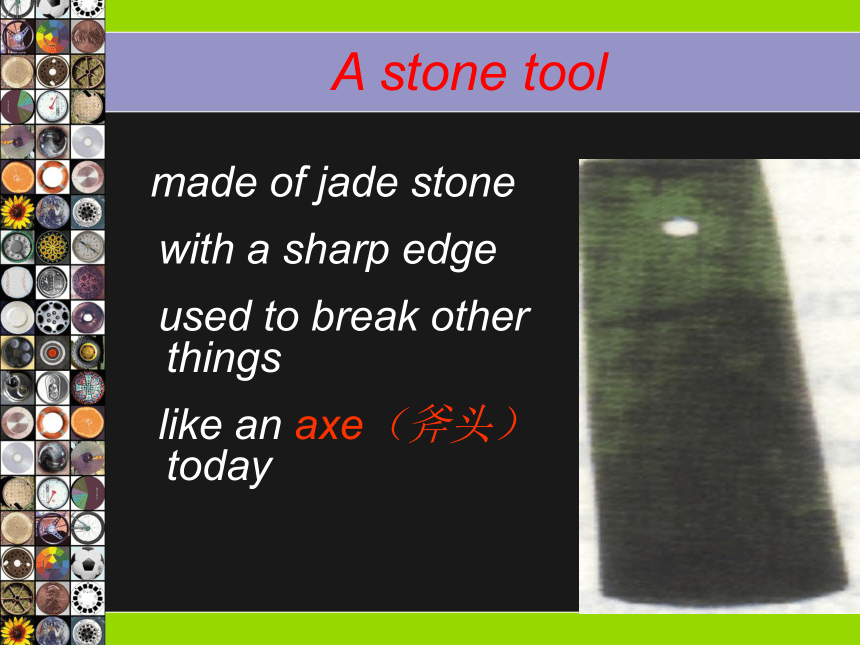
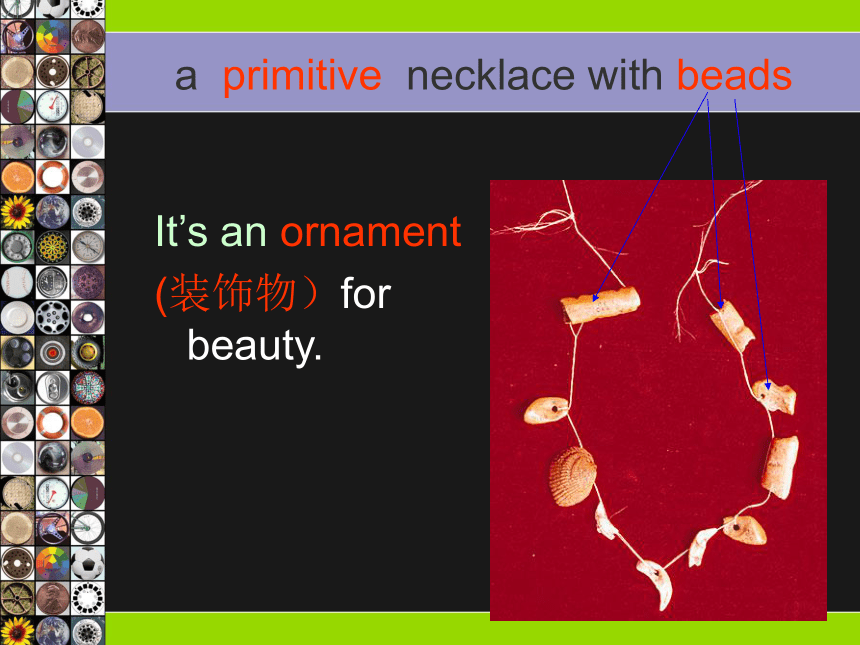
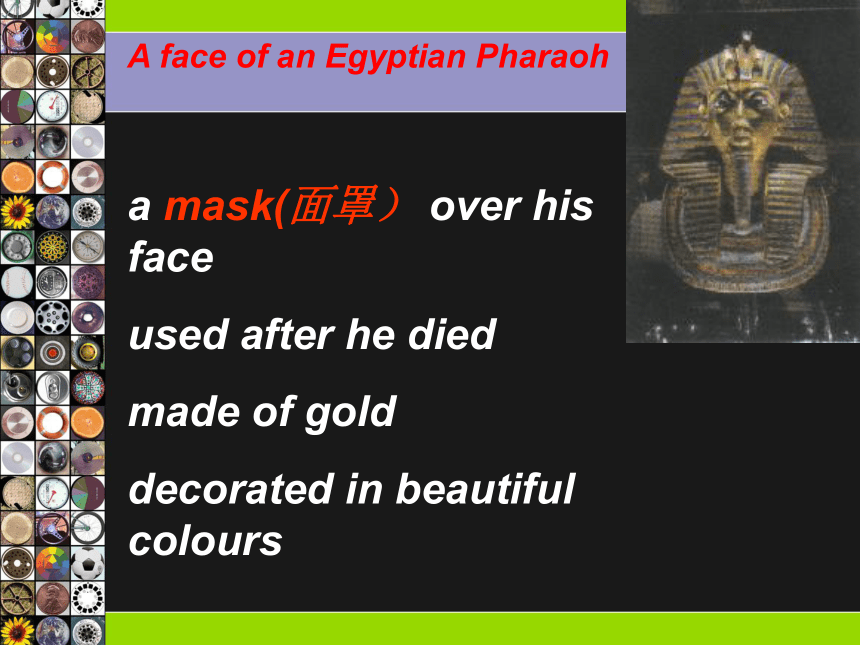
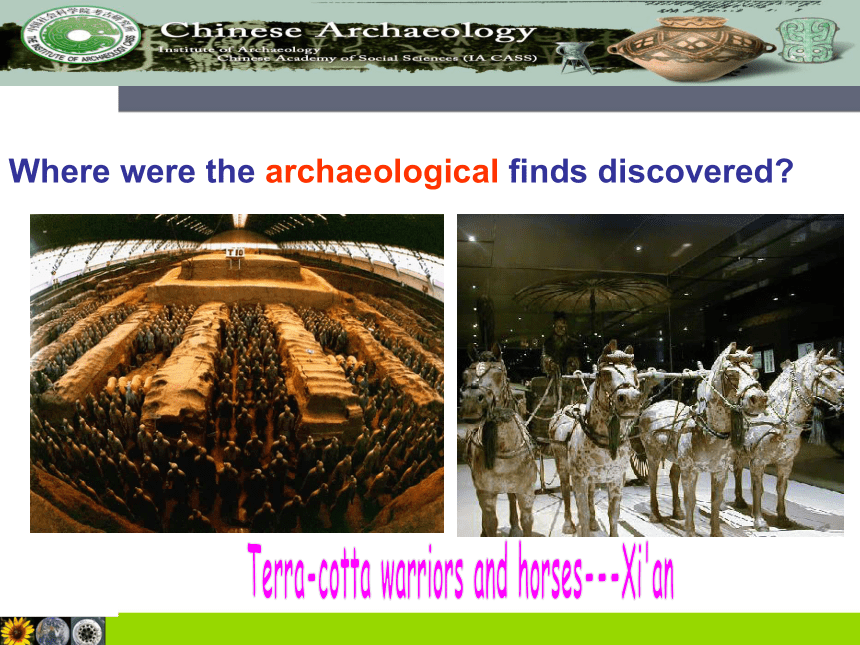

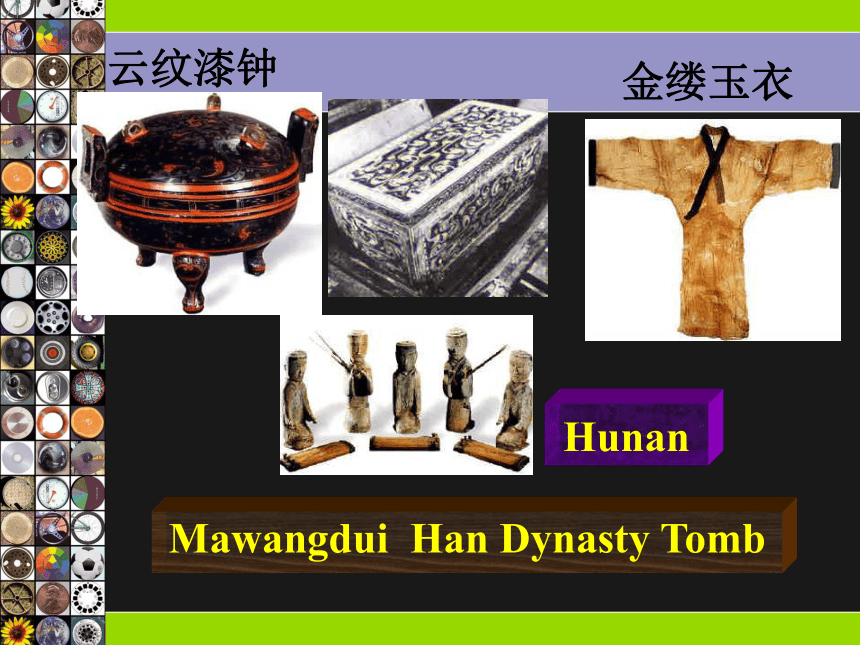
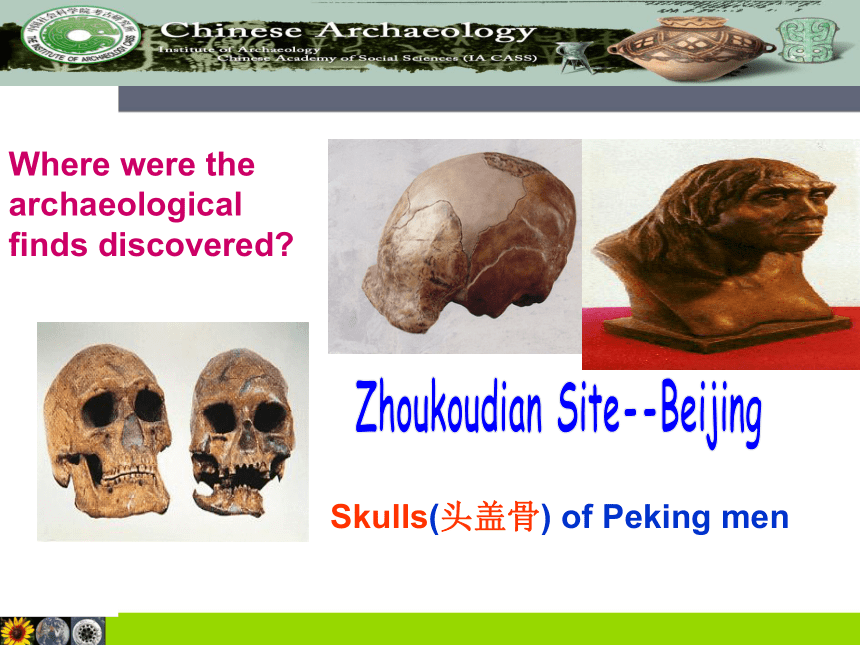
文档简介
(共35张PPT)
Unit 5
Meeting
your ancestors
Which of them is the closest definition of archaeology A. A study of old buildings B. A collection of dead people and their objects C. A study of ancient societies by examining the objects they used D. A study of past societies
archaeology
What jobs should an archaeologist do
excavate
collect
analyze
identify
provided light at night
made use of olive oil
burned a thread from inside the lamp
An oil lamp
from Greece
Learn about some archaeological finds:
Chinese chimes
a musical instrument
playing notes by hitting the bells
played in a large house, temple or palace
A stone tool
made of jade stone
with a sharp edge
used to break other things
like an axe(斧头) today
a primitive necklace with beads
It’s an ornament
(装饰物)for beauty.
A face of an Egyptian Pharaoh
a mask(面罩) over his face
used after he died
made of gold
decorated in beautiful colours
Where were the archaeological finds discovered
金面铜人头像
铜兽面
玉璋
青铜纵目面具
Sanxingdui Museum
Sichuan
Mawangdui Han Dynasty Tomb
金缕玉衣
云纹漆钟
Hunan
Skulls(头盖骨) of Peking men
Where were the archaeological finds discovered
Try a tentative guess about Peking Man’s history in Zhoukoudian Caves:
Dating back to 600,000 years ago.
Dating back to 600,00 years ago.
Dating back to 6,000 years ago.
.
Reading
Which of the following is false
They used fire to keep them warm, cook the food and scare the animals.
They took animal skins to keep out the cold.
They gather in their own crops.
They care about their appearance.
2. The main idea is about the ____ of our earliest people in the Zhoukoudian Caves.
A. homes and fishing
B. food and clothing
C. life and habits
D farming and hunting
3. Through the conversation, _____ is not mentioned.
A. homes B. tools
C. entertainment D. clothes
4. They may keep themselves warm by the following except____.
A. wearing clothes made from animal skins
B. keeping fire burning
C. living in a group
D. hanging animal skins at the entrance of the cave
5. Evidence has shown early people in the caves used _____ to make clothes.
A. leaves B. tree skins
C. animal skins D. cotton
6. From the conversation we can infer early people in the Caves were ________.
A. busy and rich
B. idle and lazy
C. clever and hard-working
D. stupid and cruel
7. Which of the following shows us the earliest people and the modern people have something in common
A. People hung animal skins to keep out the cold
B. People never grew their own crops
C. People use science
D. People care about their appearance
8. What can we infer from the sentences--- “This one looks very like a fish bone. Is it reasonable ---Yes indeed, as the botanical analyses have been specifically showing us, all the fields around here used to be part of a large shallow lake. Undoubtedly there were fish swimming in it.”
A. Being an archaeologist needs a wide range of knowledge.
B. A lake is not the sea.
C. People can identify the fish by the colour.
D. A fish bone can be made into a necklace.
What objects are mentioned in the text
cave
needle
necklace
fire
clothes
stones
Stage 1
life in the cave
Stage 2
What we can learn from a needle
Stage 3
What we learn from a necklace
The dialogue can be divided into three
stages according to archaeology.
1. How did they keep warm
made fires
kept fires burning
hung animal skins at the cave mouth
2. What animals were their most dangerous enemies
Tigers and bears
Read stage 1 life in the cave
Read stage 2 information about the needle
Object What can be discovered from it
Needle 1. They repaired or made ________.
2. The needle is at most three ___________ long.
3. _________ tools have been used to _______ the animals, ______ the skins and clean them with_________.
Guess: So early people probably ______ animal skins.
clothes
wore
scrapers
centimeters
Sharpened
cut up
remove
How did they make clothes
Their clothes were made from animal_____. They used __________stone tools to ___ __ the animals and _______ their skin. Then smaller _______were used to clean the fat and meat from them. They had to ____an ample amount of salt inside the skin to make it _____enough.
Finally, they would have cut it and ______the pieces together with _______ made of animal bones.
skins
sharpened
scrapers
rub
cut up
remove
soft
sewn
needles
Read stage 3 About the necklace
1.What is the necklace made of
seashells
animal bones
fish bones
2.What are the two words used to describe it
Primitive
well preserved
Object What can be discovered from it
necklace 1. They cared about their __________.
2. Some of the beads were made of ___________.
Guess: So early people killed, _______ and most probably ate animals
3. Some of the bead were made of __________.
Guess: So early people ________ and probably _____ fish in the _______ lake (as shown by botanical analyses).
4. Some of the beads were made of _________.
Guess: So early people may have ________ to the sea or ________ with people who had seashells.
appearance
animal bones
cut up
fish bones
caught ate
nearby
travelled traded
seashells
Fill in the blanks according to the first letter given.
According to all the things found in and near the Zhoukoudian Cave, scientists have come to a c________ that there used to be early people living in it. If you are still thinking about the a_______ places to spend your holiday, I suggest you go there. Every visitor must be a____ how surprising it is but it is reasonable to a_____ they lived in those caves, r________ of the cold .
onclusion
lternative
ware
ssume
egardless
They made f___ to keep themselves warm, cook the food and scare wild animals away. They made the bones of animals into n______ and wore c_____ made of animal skin. They really cared about their a_________. They wore beads made of animal bones and s_______. They didn’t grow their own c____ but they picked fruit and killed animals.
ires
eedles
lothes
ppearance
eashells
rops
elements
Unit 5
Meeting
your ancestors
Which of them is the closest definition of archaeology A. A study of old buildings B. A collection of dead people and their objects C. A study of ancient societies by examining the objects they used D. A study of past societies
archaeology
What jobs should an archaeologist do
excavate
collect
analyze
identify
provided light at night
made use of olive oil
burned a thread from inside the lamp
An oil lamp
from Greece
Learn about some archaeological finds:
Chinese chimes
a musical instrument
playing notes by hitting the bells
played in a large house, temple or palace
A stone tool
made of jade stone
with a sharp edge
used to break other things
like an axe(斧头) today
a primitive necklace with beads
It’s an ornament
(装饰物)for beauty.
A face of an Egyptian Pharaoh
a mask(面罩) over his face
used after he died
made of gold
decorated in beautiful colours
Where were the archaeological finds discovered
金面铜人头像
铜兽面
玉璋
青铜纵目面具
Sanxingdui Museum
Sichuan
Mawangdui Han Dynasty Tomb
金缕玉衣
云纹漆钟
Hunan
Skulls(头盖骨) of Peking men
Where were the archaeological finds discovered
Try a tentative guess about Peking Man’s history in Zhoukoudian Caves:
Dating back to 600,000 years ago.
Dating back to 600,00 years ago.
Dating back to 6,000 years ago.
.
Reading
Which of the following is false
They used fire to keep them warm, cook the food and scare the animals.
They took animal skins to keep out the cold.
They gather in their own crops.
They care about their appearance.
2. The main idea is about the ____ of our earliest people in the Zhoukoudian Caves.
A. homes and fishing
B. food and clothing
C. life and habits
D farming and hunting
3. Through the conversation, _____ is not mentioned.
A. homes B. tools
C. entertainment D. clothes
4. They may keep themselves warm by the following except____.
A. wearing clothes made from animal skins
B. keeping fire burning
C. living in a group
D. hanging animal skins at the entrance of the cave
5. Evidence has shown early people in the caves used _____ to make clothes.
A. leaves B. tree skins
C. animal skins D. cotton
6. From the conversation we can infer early people in the Caves were ________.
A. busy and rich
B. idle and lazy
C. clever and hard-working
D. stupid and cruel
7. Which of the following shows us the earliest people and the modern people have something in common
A. People hung animal skins to keep out the cold
B. People never grew their own crops
C. People use science
D. People care about their appearance
8. What can we infer from the sentences--- “This one looks very like a fish bone. Is it reasonable ---Yes indeed, as the botanical analyses have been specifically showing us, all the fields around here used to be part of a large shallow lake. Undoubtedly there were fish swimming in it.”
A. Being an archaeologist needs a wide range of knowledge.
B. A lake is not the sea.
C. People can identify the fish by the colour.
D. A fish bone can be made into a necklace.
What objects are mentioned in the text
cave
needle
necklace
fire
clothes
stones
Stage 1
life in the cave
Stage 2
What we can learn from a needle
Stage 3
What we learn from a necklace
The dialogue can be divided into three
stages according to archaeology.
1. How did they keep warm
made fires
kept fires burning
hung animal skins at the cave mouth
2. What animals were their most dangerous enemies
Tigers and bears
Read stage 1 life in the cave
Read stage 2 information about the needle
Object What can be discovered from it
Needle 1. They repaired or made ________.
2. The needle is at most three ___________ long.
3. _________ tools have been used to _______ the animals, ______ the skins and clean them with_________.
Guess: So early people probably ______ animal skins.
clothes
wore
scrapers
centimeters
Sharpened
cut up
remove
How did they make clothes
Their clothes were made from animal_____. They used __________stone tools to ___ __ the animals and _______ their skin. Then smaller _______were used to clean the fat and meat from them. They had to ____an ample amount of salt inside the skin to make it _____enough.
Finally, they would have cut it and ______the pieces together with _______ made of animal bones.
skins
sharpened
scrapers
rub
cut up
remove
soft
sewn
needles
Read stage 3 About the necklace
1.What is the necklace made of
seashells
animal bones
fish bones
2.What are the two words used to describe it
Primitive
well preserved
Object What can be discovered from it
necklace 1. They cared about their __________.
2. Some of the beads were made of ___________.
Guess: So early people killed, _______ and most probably ate animals
3. Some of the bead were made of __________.
Guess: So early people ________ and probably _____ fish in the _______ lake (as shown by botanical analyses).
4. Some of the beads were made of _________.
Guess: So early people may have ________ to the sea or ________ with people who had seashells.
appearance
animal bones
cut up
fish bones
caught ate
nearby
travelled traded
seashells
Fill in the blanks according to the first letter given.
According to all the things found in and near the Zhoukoudian Cave, scientists have come to a c________ that there used to be early people living in it. If you are still thinking about the a_______ places to spend your holiday, I suggest you go there. Every visitor must be a____ how surprising it is but it is reasonable to a_____ they lived in those caves, r________ of the cold .
onclusion
lternative
ware
ssume
egardless
They made f___ to keep themselves warm, cook the food and scare wild animals away. They made the bones of animals into n______ and wore c_____ made of animal skin. They really cared about their a_________. They wore beads made of animal bones and s_______. They didn’t grow their own c____ but they picked fruit and killed animals.
ires
eedles
lothes
ppearance
eashells
rops
elements
